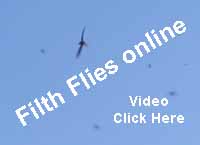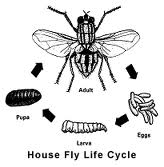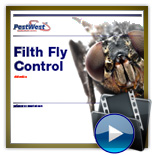Pollution
on the Tusket
Tricounty Watershed Protection Association
Filth Flies
by G.J.LeBlanc
Return to Home Page
Tricounty Watershed Protection Association
Filth Flies
by G.J.LeBlanc
Return to Home Page
 FAQ: Filth Flies: The house fly and other types of “filth
flies” can become nuisance pests, but also are
important for their potential to harm humans and
animals. The habits of filth
flies favor the spread of bacteria and other
disease-causing organisms. Filth flies often
feed and lay eggs on garbage, manure and
carrion .Filth flies
pick up pathogenic organisms from sewage, garbage, manure,
decaying bodies and other such sources. (S) FAQ: Filth Flies: The house fly and other types of “filth
flies” can become nuisance pests, but also are
important for their potential to harm humans and
animals. The habits of filth
flies favor the spread of bacteria and other
disease-causing organisms. Filth flies often
feed and lay eggs on garbage, manure and
carrion .Filth flies
pick up pathogenic organisms from sewage, garbage, manure,
decaying bodies and other such sources. (S)
|
|
|
From: Orville Pulsifer
<pulsifer2@eastlink.ca>
To: webmaster@yarmouth.org
Subject: Controlling filth flies on Mink FarmsI am hoping to get in touch
with a contact or contacts who have an
interest in better controlling filth flies
on mink farms. I hope you may be able to
help in that regard, please.
Orville
B. Pulsifer McFetridge
Farm c/o
107-49 Kaulback St.
Truro, N.S.
B2N 0B7
Cell 902-890-6683
|
|
| A key to success in fly
control is to have a clear understanding of fly biology.
The flies that plague us during the peak summer months all
have complete metamorphosis. The life cycle of the fly can
be as short as nine days. The eggs can hatch within a
24-hour period. The maggots, which require a warm, moist
environment to survive, will seek out manure piles,
spilled feed, or other environments ideal to grow and
pupate. In three or four days, the maggots will enter the
pupal stage and, if the temperature remains above 85
degrees, the new adult flies will emerge in three short
days. (more) |
 |
| More than you probably want to know
about filth flies. PDF format Filth flies can carry over 100 human pathogens ... Filth flies are labeled such due to their association with carrion, feces, ... species identification is key to locating ... http://www.pestwest.com/us/downloads/Filth_Fly_Control_iBook.pdf |
 |
| 1.
Diptera Associated with
Livestock Dung 2. How to kill and control flies |
|